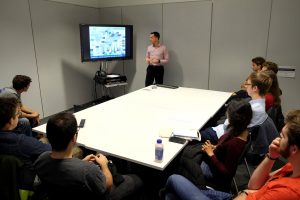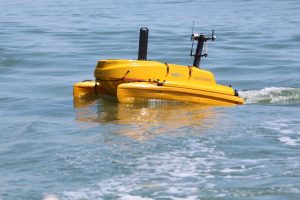
In January 2018, The Maritime Robotics Laboratory took delivery of the C-Cat 3 – a 3m autonomous catamaran from ASV Global. The vessel is the first of a new class of vessels for ASV and is small enough to easily transport and mobilise but is able to carry a significant range of payloads.
The vessel will be used both for scientific and engineering research in the development of autonomous systems. The investment was funded by an EPSRC RAS Capital Award.

As part of the vessel delivery, Dr Blair Thornton, Dr Nick Townsend and Dr Jon Downes undertook a C-Cat 3 specific ASV Remote Operator Course with ASV Global. This involved undertaking the RYA powerboat level 2 handling course (including a very wet passage from Porchester to Cowes and back) and 3 days operations with the C-Cat3 from a support vessel. All involved were very grateful for the efforts of ASV Global to run this course which provided good insights into the workings of the ASView® system and experience of operating this class of vessel.
See also: https://www.asvglobal.com/university-southampton-takes-delivery-asv-global-c-cat-3-autonomous-vessel/
All posts by Stephen Turnock
How to study the biodiversity of the seabed
Jin Wei Lim, a Leverhulme Trust PhD student in the Faculty of Engineering and the Environment at the University of Southampton has been awarded first place in the OCEANS’18 MTS/IEEE conference help at the Kobe Convention Center in Japan. This year’s competition had more than 100 entries from around the world. The best fifteen entries were chosen to present their posters to a panel of 11 judges, with the best three posters being awarded prizes at a ceremony held during the conference gala dinner.
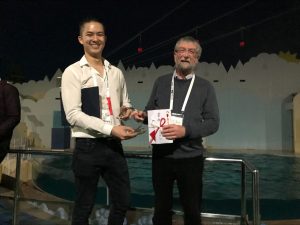
The winning poster, entitled ‘Automated Interpretation of Seafloor Visual Maps Obtained using Underwater Robots’ demonstrates the feasibility of using Convolutional Neural Networks (CNNs) to automatically interpret large visual maps of the seafloor in volcanically active regions. These regions are often densely populated by deep-sea biological communities and the ability to efficiently document the diversity and distribution of different species over large spatial scales is critical for monitoring the environmental in the context of deep-sea mining. The study shows how the manual process of identifying and annotating individual animals can be automated given a sufficient number of labelled examples. The study further demonstrates how the classification uncertainty of the automated algorithm relates to the number of training examples used for different species of animal, giving important insights regarding how human efforts can be optimized and best leveraged by machines.
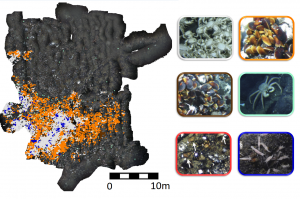
Jin Wei commented “This conference has been an eye opening experience. I am really honoured to be able to share my work on this prestigious program, and meet many amazing industry professionals and researchers from all around the globe.”
The research was carried out by Jin Wei as part of his undergraduate final year individual project with the Fluid Structure Interactions group. Jin Wei is currently looking at characterising uncertainty in automated data processing techniques used in ocean research under the supervision of Dr Blair Thornton, Prof Adam Prugel-Bennet and Prof Damon Teagle.
2018 Open days coming soon
The Ship science team will be welcoming visitors this summer and autumn as part of the University of Southampton’s Open Days.

Talks will give opportunities to learn more about the maritime sector and the exciting careers possible with a degree in Ship Science as well as demonstrations in our impressive 138 m long , 6 m wide and 3.5 m long wave and towing tank.
Maritime is a rapidly growing sector where there is significant skills shortage. A recent article by the chair of Maritime UK, Ocean economy offers UK a trillion pound opportunity in undiscovered gold and precious metals highlights what are seen as the many opportunities enabled by the 4th industrial revolution enabled by digital technology. Ship scientists and maritime engineers are at the heart of the application of the new developments in technology ensuring that these can be applied safely and in an environmentally sensitive way.
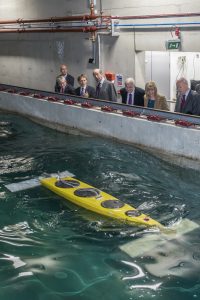
Our staff and students will be on hand to explain and answer any questions you might have.
World Sailing Robot Championship coming to Southampton
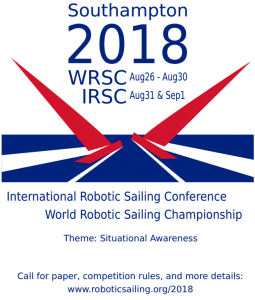 Dr Nick Townsend is the lead academic supporting an enthusiastic team of Doctoral and undergraduate students hostng the World Robot Sailing Chmapionship at the end of August 2018. There are still places for teams to enter so sign up soon!
Dr Nick Townsend is the lead academic supporting an enthusiastic team of Doctoral and undergraduate students hostng the World Robot Sailing Chmapionship at the end of August 2018. There are still places for teams to enter so sign up soon!
Maritime Masters
MaritimeUK has recently highlighted the on-going collaborations between University and Industry to enhance the UK’s maritime sector capabilities.
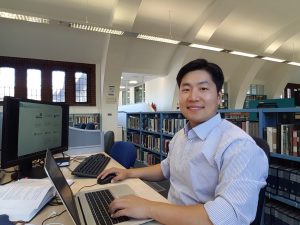 Current Maritime Engineering MSc student Hongseok Bae discusses his research project into the use of AIS data to evaluate ship operational efficiency. The Automatic Identification System (AIS) is fitted on board all large ships and provides a continual update as to a particular vessel’s position, speed and other operational data via radio connections to land or satellite receivers. Models can be built to estimate for a given ship speed and type what emissions will be generated.
Current Maritime Engineering MSc student Hongseok Bae discusses his research project into the use of AIS data to evaluate ship operational efficiency. The Automatic Identification System (AIS) is fitted on board all large ships and provides a continual update as to a particular vessel’s position, speed and other operational data via radio connections to land or satellite receivers. Models can be built to estimate for a given ship speed and type what emissions will be generated.
The University of Southampton’s expertise in marine and maritime disciplines is nurtured through the Southampton Marine and Maritime Institute (SMMI). SMMI is a community of academics whose interests and research are linked to the natural marine environment and the human intervened maritime realms. By working across the traditional disciplinary divides, we can better address some of today’s global marine & maritime challenges.
The SMMI constitutes world class, authoritative, independent expertise, spanning both the marine and maritime sectors. We foster new research collaborations, educate the next generation of maritime leaders, and generate knowledge and intelligence for businesses of all sizes, government at all scales and organisations of all kinds. SMMI staff and students, by themselves and in partnership with industry, create new technologies and innovations to stimulate economic growth and improve quality of life and the environment.
Summer Study in Ship Science
We are fortunate to offer three research internships based in the fluid structure interactions group. These are intended primarily for ship science students just finishing their 3rd year and provide an eight week research experience.
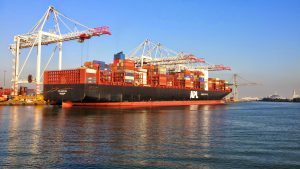
Professor Dominic Hudson is looking for someone to work Prediction of ship power using machine learning
and
Dr Joe Banks has two positions related to his work on the characterisation of the fluid structure interaction of ship propellers
Research Intern into propeller performance –
and as part of the on-going work of teh performance sports engineering lab investigating performance of elite swimmers
Research Intern into Swimming Performance –
If you are interested please contact Dominic or Joe directly.
We also have some PhD opportunities in swimming for students who qualify as suitable for EPSRC.
High performance computing solves Ship Science challenges
The fifth generation of the University of Southampton’s supercomputers Iridis 5 has come on line. It has 20,000-cores and has a peak performance of 1.3 Petaflops. A ‘flop’ is floatng point operations per second such as adding two real numbers in a second and Peta is 1 quadrillion eg 10 to the power 15 .

The 20,000-core machine was designed and built by high performance computing (HPC) integrator OCF using ThinkSystem SD530 servers from Lenovo. It has already emerged as one of the most powerful systems in the world, entering the Top500 supercomputer list in November,at number 251.

One of the key users over many years is our own Wolfson Unit for Marine Technology and Industrial Aerodynamics(WUMTIA) who provide a variety of Computational Fluid Dynamics(CFD) services to industry. Dr Sandy Wright, principal research engineer, Wolfson Unit at the University of Southampton comments in an OCF press release. “We have a worldwide customer base and have worked with the British Cycling Team for the last three Olympic games, as well as working with teams involved in the America’s Cup yacht race. In the past 10 years, Computational Fluid Dynamics (CFD) has become a perfectly valid commercial activity, reducing the need for physical experimentation. CFD gives as good an answer as the wind tunnel, without the need to build models, so you can speed up research whilst reducing costs. Iridis 5 will enable the Wolfson Unit to get more accurate results, whilst looking at more parameters and asking more questions of computational models.”
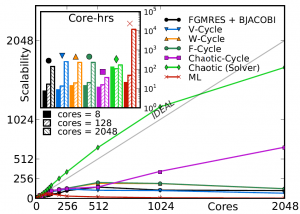
PhD students in FSI are alo important users of the Iridis computers. One example is Dr James Hawkes who recently completed his PhD in collboration with Dr Guilherme Vaz of the Refresco team at MARIN on ‘Chaotic methods for the strong scalability of CFD‘. His work investigated how best to design CFD codes of the future to work across thousands of cores.
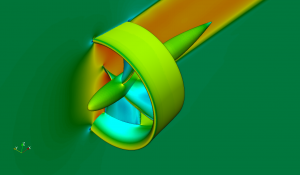
Wind tunnel tests on deep water underwater autonomous glider
As part of the BRIDGES EUH2020 (http://www.bridges-h2020.eu/). research programme the hydrodynamic performance of the external shape was successfully validaterd in the large R.J.Mitchell wind tunnel at the University of Southampton. The glider is designed to carry out long duration autonomous scientific missions down to depths of 3000m. Current underwater gliders are typically limited in depth (~150 m). This is one of the funded projects underway in the maritime robotics laboratory.
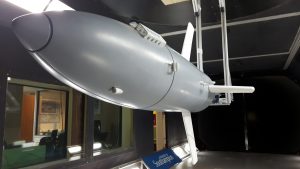
Dr Artur Lidtke , Research Fellow in the Maritime Robotics Lab at the FSI Group, carrie dout the tests over a one week period. Thanks to the size of the facility, hydrodynamic performance of the AUV could be measured at full-scale Reynolds numbers, allowing detailed quantification of drag augments associated with different vehicle configurations. The information will help to validate the design, which has been devised based on fluid dynamic simulations (CFD), allow better estimation of mission endurance, and lead to an improved understanding of performance of such AUVs in the future.
See also: https://twitter.com/BRIDGESh2020/status/956851894449827840
Maritime Robotics in San Diego for Blue Week
Dr Jon Downes attended the Maritime Alliance Bluetech week held in San Diego 6th Nov to 10th Nov as part of the UK Government delegation funded by the Foreign and Commonwealth Office Science and Innovation Network. The UK delegation included a wide range of people from UK Government, Royal Navy, MCA, NOC, UK Universities. British Embassy Washington DC, and members of the British Consulate-General in LA.
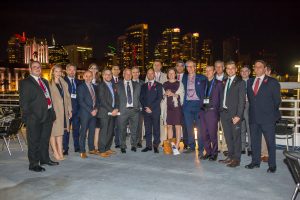
The UK Delegation attending the Maritime Alliance Bluetech Week Dinner
The delegation was visiting San Diego to build UK – US links in the Maritime Autonomous Systems sector as San Diego is home to a number of developing companies and universities. A packed week of meetings and visits ensued – visiting Scripps Institute, SPARWAR, and Coleman University Hornets Nest as part of the week. A key part of the weeks activities was the Marine Autonomous Systems UK-US Collaborative Opportunities workshop with approximately 70 attendees and a report on the discussions is expected to be made available during 2018.
The delegation attended the Maritime Alliance demonstration day witnessing some of the autonomous platforms currently under development in the US. These included the WAM-V unmanned surface vessel cooperating with underwater and aerial platforms.

Thanks to the dedication and hardwork organising this event of David Pasquini, Nick Hooper, Natalie Hatour, and Pauline Wood of the British Consulate-General in LA, this was an excellent opportunity to build links both internationally with the USA and also within the UK Delegation itself. Some final hours were used to visit the aircraft carrier USS Midway.

Maritime Careers
Ship Science and the University Careers and Employability Service recently held the 1st Maritime Careers Event. This was hosted on the Boldrewood campus with many companies stands and talks being given.
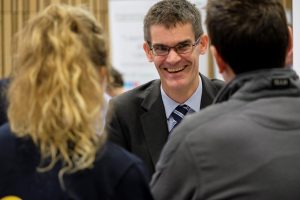
The event was well attended by 120 students from Ship science, other engineering disciplines, and maritime law during the day. Feedback from both employers and students has been very positive and we hope to be able to hold the event again next year so watch this space!
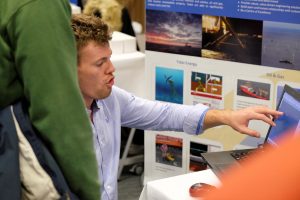
Companies attending and most of whom gave presentations included: Babcock International Group, BP, Cammell Laird, Fugro GB Marine Ltd, Griffon Hoverwork, LOC Group Ltd, LR, QinetiQ, Shell, Sonardyne, Steller Systems Ltd, Tadek, Wartsilla UK Ltd. Many of whom sent recent (or not so recent) ship science graduates!
